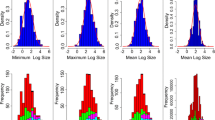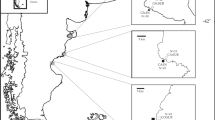Abstract
Variation in animal body size is the result of a complex interplay between variation in cell number and cell size, but the latter has seldom been considered in wide-ranging comparative studies, although distinct patterns of variation have been described in the evolution of different lineages. We investigated the correlation between epidermal cell size and body size in a sample of 29 geophilomorph centipede species, representative of a wide range of body sizes, from 6 mm dwarf species to gigantic species more than 200 mm long, exploiting the marks of epidermal cells on the overlying cuticle in the form of micro-sculptures called scutes. We found conspicuous and significant variation in average scute area, both between suprageneric taxa and between genera, while the within-species range of variation is comparatively small. This supports the view that the average epidermal cell size is to some extent taxon specific. However, regression analyses show that neither body size nor the number of leg-bearing segments explain this variation, which suggests that cell size is not an usual target of change for body size evolution in this group of arthropods, although there is evidence of its correlation with other morphological variables, like cuticle thickness. Scute sizes of miniaturized geophilomorph species are well within the range of the lineage to which the species belong, suggesting recent evolutionary transitions to smaller body size.






Similar content being viewed by others
References
Arendt J (2007) Ecological correlates of body size in relation to cell size and cell number: patterns in flies, fish, fruits and foliage. Biol Rev 82:241–256
Azevedo RBR, French V, Partridge L (2002) Temperature modulates epidermal cell size in Drosophila melanogaster. J Insect Physiol 48:231–237
Beutel RG, Haas A (1998) Larval head morphology of Hydroscapha natans LeConte, 1874 (Coleoptera, Myxophaga, Hydroscaphidae) with special reference to miniaturization. Zoomorphology 18:103–116
Beutel RG, Pohl H, Hunefeld F (2005) Strepsipteran brains and effects of miniaturization (Insecta). Arthropod Struct Dev 34:301–313
Blomberg SP, Garland T Jr (2002) Tempo and mode in evolution: phylogenetic inertia, adaptation and comparative methods. J Evol Biol 10:899–910
Bonato L, Foddai D, Minelli A (2003) Evolutionary trends and patterns in centipede segment number based on a cladistic analysis of Mecistocephalidae (Chilopoda: Geophilomorpha). Syst Entomol 28:539–579
Bonato L, Drago L, Murienne J (2014a) Phylogeny of Geophilomorpha (Chilopoda) inferred from new morphological and molecular evidence. Cladistics 30:485–507
Bonato L, Edgecombe GD, Minelli A (2014b) Geophilomorph centipedes from the Cretaceous amber of Burma. Paleontology 57:97–110
Brena C, Cima F, Burighel P (2003) Alimentary tract of Kowalevskiidae (Appendicularia, Tunicata) and evolutionary implications. J Morph 258:225–238
Cals P (1974) Mise en évidence, par le microscope électronique à balayage, de champs morphogénétiques polarisés, exprimés par les cellules épidermiques normales dans l’appendice locomoteur des Arthropodes: Tylos latreilli (Audouin) (Crustacé, Isopode) et Periplaneta americana (L.) (Insecte Dictyoptère). C R Acad Sci Paris 279D:663–666
Conlon I, Raff M (1999) Size control in animal development. Cell 96:235–244
De Moed GH, De Jong G, Scharloo W (1997) Environmental effects on body size variation in Drosophila melanogaster and its cellular basis. Genet Res 70:35–43
Foddai D, Bonato L, Pereira L, Minelli A (2003) Phylogeny and systematics of the Arrupinae (Chilopoda: Geophilomorpha: Mecistocephalidae) with the description of a new dwarfed species. J Nat Hist 37:1247–1267
Fusco G (2005) Trunk segment numbers and sequential segmentation in myriapods. Evol Dev 7:608–617
Fusco G, Minelli A (2013) Arthropod body segments and tagmata. In: Minelli A, Boxshall G, Fusco G (eds) Arthropod biology and evolution. Molecules, development, morphology. Springer, Berlin, pp 197–221
Fusco G, Brena C, Minelli A (2000) Cellular processes in the growth of lithobiomorph centipedes (Chilopoda: Lithobiomorpha). A cuticular view. Zool Anz 239:91–102
Gibson WT, Gibson MC (2009) Cell topology, geometry, and morphogenesis in proliferating epithelia. Curr Top Dev Biol 89:87–114
Gibson MC, Patel AB, Nagpal R, Perrimon N (2006) The emergence of geometric order in proliferating metazoan epithelia. Nature 442:1038–1041
Grassé PP (1975) La cuticule. In: Grassé PP (ed) Traité de Zoologie, Tome VIII, Fascicule III, Insectes: Téguments, Système nerveux. Organes sensoriels. Masson, Paris, pp 5–31
Guillot C, Lecuit T (2013) Mechanics of epithelial tissue homeostasis and morphogenesis. Science 340:1185–1189
Hinton HE (1970) Some little known surface structures. Symp R Ent Soc Lond 5:41–58
Kristensen RM (1991) Loricifera. In: Harrison FW, Woollacott RM (eds) Microscopic anatomy of invertebrates, Vol. 4, Aschelminthes. Wiley-Liss, New York, pp 351–375
Leśniewska M, Bonato L, Minelli A, Fusco G (2009) Trunk anomalies in the centipede Stigmatogaster subterranea provide insight into late-embryonic segmentation. Arthropod Struct Dev 38:417–426
Minelli A, Maruzzo D, Fusco G (2010) Multi-scale relationships between numbers and size in the evolution of arthropod body features. Arthropod Struct Dev 39:468–477
Moussian B (2013) The arthropod cuticle. In: Minelli A, Boxshall G, Fusco G (eds) Arthropod biology and evolution. Molecules, development, morphology. Springer, Berlin, pp 171–196
Neves RC, Sørensen KJK, Kristensen RM, Wanninger A (2009) Cycliophoran dwarf males break the rule: high complexity with low cell numbers. Biol Bull 217:2–5
Nijhout HF (2003) The control of body size in insects. Dev Biol 261:1–9
Nijhout HF, Callier V (2015) Developmental mechanisms of body size and wing-body scaling in insects. Annu Rev Entomol 60:141–156
Nijhout HF, Cinderella M, Grunert LW (2014) The development of wing shape in Lepidoptera: mitotic density, not orientation, is the primary determinant of shape. Evol Dev 16:68–77
Partridge L, Barrie B, Fowler K, French V (1994) Evolution and development of body size and cell size in Drosophila melanogaster in response to temperature. Evolution 48:1269–1276
Pereira LA (2013) Discovery of a second geophilomorph species (Myriapoda: Chilopoda) having twenty-seven leg-bearing segments, the lowest number recorded up to the present in the centipede order Geophilomorpha. Pap Avulsos Zool (São Paulo) 53:163–185
Polilov AA (2015) Small is beautiful: features of the smallest insects and limits to miniaturization. Annu Rev Entomol 60:103–121
Robertson FW (1959) Studies in quantitative inheritance. XII. Cell size and number in relation to genetic and environmental variation of body size in Drosophila. Genetics 44:869–896
Rosenberg J, Müller CHG, Hilken G (2011) The Chilopoda—integument and associated organs—integument and cuticle. In: Minelli A (ed) Treatise on zoology—the Myriapoda, vol 1. Brill, Leiden, pp 67–70
Roth G, Blanke J, Wake DB (1994) Cell size predicts morphological complexity in the brains of frogs and salamanders. Proc Natn Acad Sci USA 91:4796–4800
Roth G, Rotluff B, Blanke J, Ohle M (1995) Brain size and morphology in miniaturized plethodontid salamanders. Brain Behav Evol 45:84–95
Schmelzle T, Hall MN (2000) TOR, a central controller of cell growth. Cell 103:253–262
Stevenson RD, Hill MF, Bryant PJ (1995) Organ and cell allometry in Hawaiian Drosophila: how to make a big fly. Proc R Soc Lond B 259:105–110
Stocker H, Hafen E (2000) Genetic control of cell size. Curr Opin Genet Dev 10:529–535
Trumpp A, Refaeli Y, Thordur Oskarsson T, Gasser S, Murphy M, Martin GR, Bishop JM (2001) c-Myc regulates mammalian body size by controlling cell number but not cell size. Nature 414:768–773
Acknowledgments
We are indebted to Luis Pereira for access to his detailed drawings of Dinogeophilus oligopodus and Ityphilus donatellae, Lucio Bonato for suggesting a possible correlation between scute size and cuticle thickness, and Leandro Drago for kindly allowing us to use a SEM photograph of his as our Fig. 1. Wallace Arthur, Lucio Bonato, Carsten H. G. Müller, and two anonymous referees provided insightful comments on a previous version of the manuscript.
Author information
Authors and Affiliations
Corresponding author
Additional information
Communicated by: Sven Thatje
Rights and permissions
About this article
Cite this article
Moretto, M., Minelli, A. & Fusco, G. Cell size versus body size in geophilomorph centipedes. Sci Nat 102, 16 (2015). https://doi.org/10.1007/s00114-015-1269-4
Received:
Revised:
Accepted:
Published:
DOI: https://doi.org/10.1007/s00114-015-1269-4




